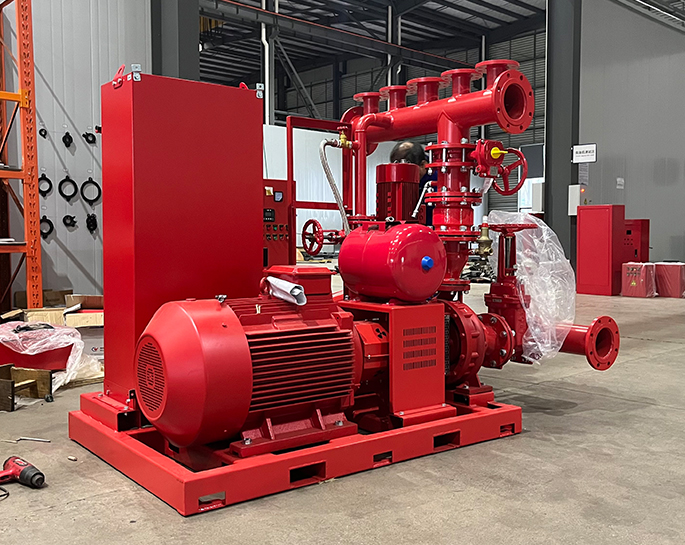What are the considerations for selecting the appropriate enclosure or housing for an electric fire pump installation in corrosive environments?
Apr 07, 2024
Share:
Selecting the appropriate enclosure or housing for an electric fire pump installation in corrosive environments requires careful consideration of several factors to ensure safety, longevity, and compliance with relevant standards. Here are some key considerations:
1. **Corrosion Resistance**: The primary concern in corrosive environments is selecting materials that can withstand corrosion. Enclosures made from stainless steel, fiberglass-reinforced polyester (FRP), or specially coated metals like aluminum with epoxy or polyester powder coating are commonly used for their corrosion-resistant properties.
2. **Sealing**: The enclosure should provide effective sealing to prevent corrosive agents from penetrating inside. This might involve gaskets, seals, or welded seams to ensure a tight barrier against corrosive elements.
3. **Ventilation**: Proper ventilation is essential to prevent the buildup of corrosive gases or moisture inside the enclosure. However, in some cases, ventilation may introduce more corrosive agents. Ventilation systems should be carefully designed to balance airflow and protection.
4. **Accessibility**: The enclosure must allow easy access for maintenance and inspection while providing sufficient protection against corrosive elements. This might involve hinged or removable panels secured with corrosion-resistant hardware.
5. **Compliance**: Ensure that the selected enclosure meets relevant industry standards and regulations for fire pump installations in corrosive environments. This might include standards set by organizations such as the National Fire Protection Association (NFPA) or local building codes.
6. **Size and Configuration**: The size and configuration of the enclosure should accommodate the electric fire pump and associated components comfortably while allowing for adequate clearance for maintenance activities.
7. **Environmental Conditions**: Consider the specific environmental conditions of the installation site, such as temperature extremes, humidity levels, exposure to chemicals, and the presence of airborne corrosive agents. Choose materials and designs that can withstand these conditions.
8. **Fire Protection Requirements**: Ensure that the enclosure provides sufficient fire protection for the electric fire pump installation, considering factors such as fire resistance ratings and the presence of fire suppression systems.
9. **Cost and Lifecycle Considerations**: Evaluate the cost of the enclosure against its expected lifecycle and maintenance requirements. While corrosion-resistant materials may have a higher initial cost, they can offer long-term savings by reducing the need for repairs and replacements.
10. **Manufacturer Recommendations**: Consult with the manufacturer of the electric fire pump and any associated equipment for recommendations on suitable enclosure materials and designs based on the specific requirements of the installation and the expected environmental conditions.

1. **Corrosion Resistance**: The primary concern in corrosive environments is selecting materials that can withstand corrosion. Enclosures made from stainless steel, fiberglass-reinforced polyester (FRP), or specially coated metals like aluminum with epoxy or polyester powder coating are commonly used for their corrosion-resistant properties.
2. **Sealing**: The enclosure should provide effective sealing to prevent corrosive agents from penetrating inside. This might involve gaskets, seals, or welded seams to ensure a tight barrier against corrosive elements.
3. **Ventilation**: Proper ventilation is essential to prevent the buildup of corrosive gases or moisture inside the enclosure. However, in some cases, ventilation may introduce more corrosive agents. Ventilation systems should be carefully designed to balance airflow and protection.
4. **Accessibility**: The enclosure must allow easy access for maintenance and inspection while providing sufficient protection against corrosive elements. This might involve hinged or removable panels secured with corrosion-resistant hardware.
5. **Compliance**: Ensure that the selected enclosure meets relevant industry standards and regulations for fire pump installations in corrosive environments. This might include standards set by organizations such as the National Fire Protection Association (NFPA) or local building codes.
6. **Size and Configuration**: The size and configuration of the enclosure should accommodate the electric fire pump and associated components comfortably while allowing for adequate clearance for maintenance activities.
7. **Environmental Conditions**: Consider the specific environmental conditions of the installation site, such as temperature extremes, humidity levels, exposure to chemicals, and the presence of airborne corrosive agents. Choose materials and designs that can withstand these conditions.
8. **Fire Protection Requirements**: Ensure that the enclosure provides sufficient fire protection for the electric fire pump installation, considering factors such as fire resistance ratings and the presence of fire suppression systems.
9. **Cost and Lifecycle Considerations**: Evaluate the cost of the enclosure against its expected lifecycle and maintenance requirements. While corrosion-resistant materials may have a higher initial cost, they can offer long-term savings by reducing the need for repairs and replacements.
10. **Manufacturer Recommendations**: Consult with the manufacturer of the electric fire pump and any associated equipment for recommendations on suitable enclosure materials and designs based on the specific requirements of the installation and the expected environmental conditions.


.png)
.png)

.png)


